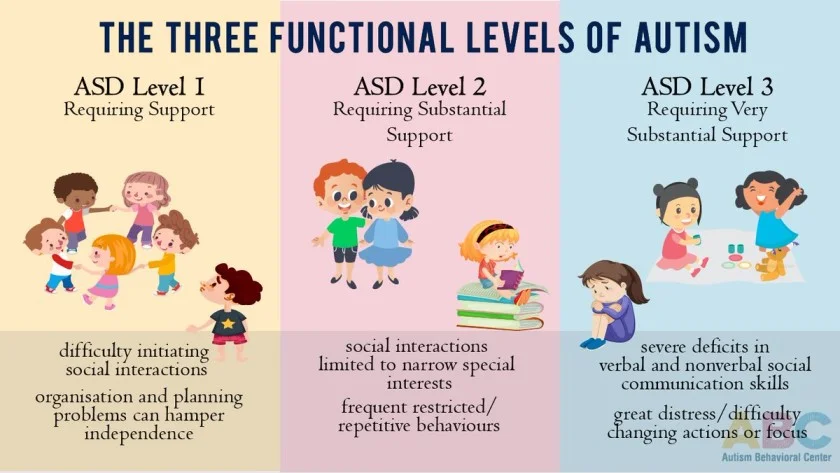Contents
By diving into this comprehensive guide on understanding ASD (Autism spectrum disorder), you will gain awareness of the early signs, empowering yourself to identify them and provide timely interventions and support. Additionally, you will:
- Gain Awareness: Understand the early signs of ASD and improve your ability to identify them, enabling early intervention and support for individuals with ASD.
- Empowerment: Learn about the diagnostic process for ASD, enabling you to advocate for yourself or your loved ones and access appropriate resources and services.
- Effective Interventions: Explore evidence-based interventions for ASD, equipping you with practical strategies to enhance communication, social skills, and overall quality of life for individuals on the autism spectrum.
Autism Resource Checklist: The three levels of autism

We found for you this insightful graph showcasing the different levels of autism. This comprehensive resource visually represents the spectrum of autism, illustrating the various levels of support and intervention required for individuals with different needs.
Gain a deeper understanding of theASD and discover how to tailor support strategies to meet the unique challenges and strengths of individuals at each level. Unlock the knowledge to effectively navigate and provide targeted assistance for individuals with ASD using this informative graph.

Doctor conducting a thorough evaluation on a child with Autism Spectrum Disorder (ASD).
Many individuals and families struggle to recognize and understand the early signs of ASD, which can delay crucial interventions and support.
This lack of awareness can lead to missed opportunities for early intervention, resulting in challenges in communication, social interaction, and overall development for individuals with ASD.
This blog post will provide invaluable insights and guidance to help readers gain a deeper understanding of ASD, learn to identify early signs, navigate the diagnostic process, and discover effective interventions.
This blog post will empower readers with the knowledge and tools necessary to recognize the early signs of ASD, facilitate timely diagnosis, and access appropriate interventions, thereby improving outcomes for individuals on the autism spectrum.
Understanding Autism: Early Signs and Identification

Doctor conducting a comprehensive examination of a child , evaluating their developmental milestones and assessing specific needs for tailored interventions and support.
Recognizing Early Signs of Autism Spectrum Disorder
- Delayed or Limited Speech Development: Many children with ASD may exhibit delays in speech or have limited language skills, such as not speaking single words by the age of two or not engaging in back-and-forth conversation.
- Social Interaction Challenges: Individuals with ASD often struggle with social interaction, including difficulties in making eye contact, understanding social cues, or engaging in reciprocal play with peers.
- Repetitive Behaviors and Fixations: Repetitive behaviors, such as hand flapping, rocking, or fixations on specific objects or topics, are common signs of ASD that may indicate the need for further evaluation.
- Sensory Sensitivities: individuals with ASD experience heightened sensitivities to sensory stimuli, such as loud noises, bright lights, or certain textures, leading to emotional distress or withdrawal.
- Unusual Communication Patterns: Autistic individuals may exhibit atypical communication patterns, such as echolalia (repeating words or phrases), difficulty understanding non-literal language, or a preference for non-verbal communication.
Diagnosing Autism: The Diagnostic Process

Doctor guiding a child with Autism Spectrum Disorder (ASD) through a physiotherapy session, promoting motor skills development and enhancing physical abilities in a specialized therapeutic setting.
Steps Involved in Diagnosing Autism Spectrum Disorder
- Screening and Observation: The diagnostic process typically involves initial screening tools and observations by healthcare professionals to identify potential signs of autism in individuals.
- Comprehensive Evaluation: A comprehensive evaluation, conducted by a team of specialists, assesses various aspects of an individual’s development, including social communication, behavior, and cognitive abilities.
- Diagnostic Criteria and Assessments: Diagnostic criteria, such as those outlined in the Diagnostic and Statistical Manual of Mental Disorders (DSM-5), guide clinicians in using standardized assessments and interviews to determine if an individual meets the criteria for an autism diagnosis.
- Collaboration with Parents and Caregivers: Parents and caregivers play a vital role in the diagnostic process by providing valuable information about the individual’s development, behavior, and challenges they observe at home and in various settings.
- Seeking Multidisciplinary Expertise: Obtaining a comprehensive diagnosis often requires input from professionals in various fields, such as psychologists, speech therapists, occupational therapists, and developmental pediatricians.
For a more comprehensive understanding of the screening and diagnosis process for Autism Spectrum Disorder (ASD), we encourage you to explore the resources provided by the Centers for Disease Control and Prevention (CDC). Their article, “Screening and Diagnosis of Autism Spectrum Disorder,” offers detailed insights into the steps involved in the diagnostic journey, including the importance of early identification and the various assessment tools used by healthcare professionals.
Interventions for Autism: Support and Strategies

Speech therapist engaging in a therapy session with a child with Autism Spectrum Disorder (ASD), fostering communication skills, language development, and promoting effective communication strategies tailored to the child’s unique needs.
Effective Interventions and Support for Autism Spectrum Disorder
- Applied Behavior Analysis (ABA): ABA is a widely recognized and evidence-based intervention that focuses on reinforcing positive behaviors and teaching new skills through structured and individualized programs.
- Speech and Language Therapy: Speech and language therapy aims to improve communication skills, including speech production, receptive and expressive language abilities, and pragmatic language use.
- Occupational Therapy: Occupational therapy addresses sensory integration, motor skills, and daily living activities to enhance an individual’s independence, self-care, and overall quality of life.
- Social Skills Training: Social skills training helps individuals with autism develop appropriate social interactions, navigate social cues, and build friendships and relationships with peers.
- Parent Education and Support
- Providing parents and caregivers with education, resources, and support networks is crucial for understanding autism, implementing strategies at home, and advocating for their child’s needs.

Speech therapist and child actively participating in a speech therapy session, utilizing interactive techniques to enhance language comprehension, expressive communication, and social interaction skills.
In conclusion, this post has shed light on the crucial aspects of understanding autism: early signs, diagnosis, and interventions. We explored the key points to recognize in identifying autism, including delayed speech development, social interaction challenges, repetitive behaviors, sensory sensitivities, and atypical communication patterns. By familiarizing ourselves with these early signs, we can take proactive steps towards early intervention and support.
We then delved into the diagnostic process, emphasizing the importance of screening, comprehensive evaluation, diagnostic criteria, and collaboration with parents and caregivers. Seeking multidisciplinary expertise allows for a thorough understanding of an individual’s needs and paves the way for tailored interventions.
Lastly, we examined effective interventions and support strategies for autism spectrum disorder. Applied Behavior Analysis (ABA), speech and language therapy, occupational therapy, social skills training, and parent education emerged as crucial components in fostering growth, communication, independence, and social interactions.
By the end of this post, you should have gained a deeper understanding of the early signs of autism, the diagnostic process involved, and the range of effective interventions available. Armed with this knowledge, individuals, families, educators, and professionals can make informed decisions, access appropriate resources, and provide the necessary support to individuals on the autism spectrum, ultimately improving their quality of life and promoting inclusivity in our communities.
Don’t miss the informative video “Early Autism Diagnosis Improves Outcomes,” offering valuable insights into the benefits of early detection and intervention for individuals with autism.
After gaining a comprehensive understanding of autism, recognizing early signs, and exploring effective interventions, it is essential for families and caregivers to build a strong support network. Connecting with other special needs families and accessing valuable resources can provide invaluable guidance and emotional support on this journey.
To further expand your knowledge and discover helpful resources, we invite you to explore our article “Building a Support Network: Resources for Special Needs Families.” It offers a wealth of information, practical tips, and additional insights to help you navigate the challenges and find the support your family deserves. [Insert the hyperlink to the article here]. Remember, you are not alone in this journey, and by joining forces with others, we can create a nurturing and inclusive environment for individuals with autism and their families.